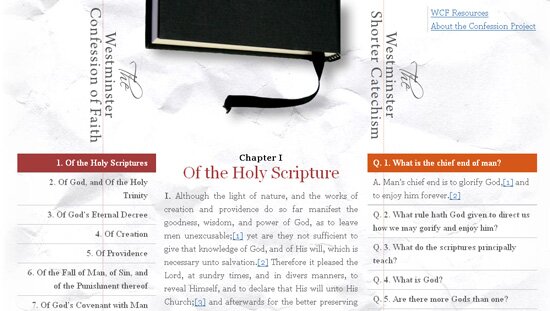Use the links below to share The Confession Project on your favorite social networks.
Back to the Article >>
The Confession Project
December 31st, 2008 in Design Inspiration
by: Matthew Griffin
In an article a few weeks ago I mentioned that it would be interesting to see how creative design could enhance classic Christian confessions and creeds. Around that time I also happened to be doing a lot of running which can be very dangerous for me. Any time I have extended periods of uninterrupted contemplation, I inevitably launch into a series of non-income-producing projects. Case in point: The Confession Project.

Why The Confession Project?
My initial research for The Confession Project led me to the unfortunate discovery that there is a noticeable lack of thoughtful design in modern Christian literature; even more so in interactive arena. There are, of course, a few glaring exceptions. For example, I've found Ligonier Ministry's Tabletalk Magazine to be well designed. But that's not the rule. Even where aesthetically pleasing graphics are employed, many times, the core design is still amateurish. The Confession Project is an attempt to begin to rectify the situation. Other philosophies are making use of the power of design; it's time Christians started doing the same.

The Confession Project is an interactive version of the Westminster Confession of Faith, the Westminster Shorter Catechism, and the Nicene Creed. The purpose of The Confession Project is to clarify and organize these classic confessions in order that Christians can more easily take them in. As a member of the Presbyterian Church in America (PCA) the Westminster Confession of Faith was, of course, a natural choice. I'm by no means implying that it is the only legitimate confession (cough. It just happens to be the best one).
Design for a Confession

For many Christians who grew up outside the confessional church, this may be your first foray into the world of classical Christianity. I hope that The Confession Project will help enrich your understanding of Christian history and dispel some common myths about confessions. Even a cursory exploration of the site will reveal that it is more Bible than confession. Each point in the Westminster Confession of Faith is carefully (and sometimes tediously) footnoted with corresponding scripture proofs. On The Confession Project, I added in a footnote lightbox to make it easy to jump over to the scripture proofs. Clicking on any footnote marker will cause a footnote lightbox to pop up.

With the help of Spry, the built-in JavaScript library in Dreamweaver, I was able to produce a semantically correct XHTML page with helpful dynamic functions. The home page of the Westminster section actually contains the entire confession with key content hidden by default. As a visitor clicks on chapter links and catechism question, additional content is revealed. The footnotes are all contained in separate pages that are pulled in using AJAX. When styles and JavaScript are disabled, the site degrades gracefully and retains all of its core functions. In the near future I'll be adding print and mobile stylesheets.
- 8 Comments
- 997 Views